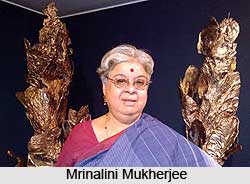 Mrinalini Mukherjee was born in Mumbai in 1949. She is the daughter of renowned artists Benode Bihari and Leela Mukherjee. She studied Painting at the Faculty of Fine Art, M.S. University, Baroda. She had also studied mural design under artists like K.G. Subramanyan and thereby received a Post-Diploma in the field in the year 1970.
Mrinalini Mukherjee was born in Mumbai in 1949. She is the daughter of renowned artists Benode Bihari and Leela Mukherjee. She studied Painting at the Faculty of Fine Art, M.S. University, Baroda. She had also studied mural design under artists like K.G. Subramanyan and thereby received a Post-Diploma in the field in the year 1970.
Her recent bronze sculptures are inspired by nature and its energies. They suggest the artfulness of ancient temples. These sculptures encompass the history of the divine icon with its origin in the organic world and the human body. The shapes the sculptor creates, using the lost-wax process of casting are symbolic of continuous movement and evolution, possessing a quality of living plants that emerge and stir and burst into flowers. These pieces are an extension of Mukherjee`s iconic early work with natural fibers like hemp, and her ceramic goddesses-blossoms series. Nature was the nourishing factor of her art. She tries to interweave nature with human sculptures.
The sculptures knotted painstakingly with hemp ropes in earthy or glowing colours evoke a rich world of growing life, lush vegetation and iconic figures. The strong note of sexuality is manifest in the mysterious folds and the intricate curves and drapes. There is a sensuous quality in her work.
The article is a stub. You can enrich by adding more information to it. Send your Write Up to content@indianetzone.com



















